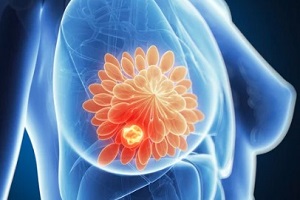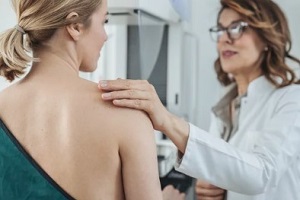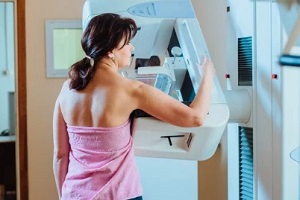 Each year, invasive breast cancer affects approximately 13 percent or about 1 in 8 American women. So, it’s critical to be familiar with your breasts and aware of any changes you might notice.
Each year, invasive breast cancer affects approximately 13 percent or about 1 in 8 American women. So, it’s critical to be familiar with your breasts and aware of any changes you might notice.
Women typically learn of breast cancer symptoms while going about their regular routines, such as taking a shower. You can avoid a lot of suffering by detecting noticeable signs of breast cancer early while it’s most treatable.
A breast lump is among the most common signs of breast cancer, but other symptoms may also be present. There is no universal lump-symptom correlation in breast cancer. This is why it’s crucial to be aware of other symptoms.
Below, you’ll find a list of other prominent signs of breast cancer. If you are experiencing any of these, schedule an appointment with your doctor immediately.
Watch for These Signs of Breast Cancer
Signs of breast cancer can differ from person to person. There is a distinction between early and late breast cancer symptoms. The earlier you notice them, the easier the cancer treatment will be.
Here are some possible signs of breast cancer.
Early Signs of Breast Cancer
 A persistent breast or underarm enlargement that persists throughout the menstrual cycle
A persistent breast or underarm enlargement that persists throughout the menstrual cycle- A new lump that persists past your next period
- Breast enlargement, skin irritation, itching, or rash
- Persistent breast soreness following your next period
- Variations in the form of the nipple
- A bloody or clear fluid secretion from the nipple
- Redness of the skin on your nipple or breast for no apparent reason
Later Signs of Breast Cancer
- Changes in breast size, shape, or contour
- A mass or lump that you may be able to feel
- Breast or nipple ulcers
- Breast discomfort
- Nipple pain
- Orange peel skin
- Scaly skin on the nipple
- Breasts with dimples or puckering
- A region that is distinguishable from all other breast regions
- A marble-like firm area under your skin
- Increasing breast veins
- Skin sores
- Nipple retraction
While these are some of the most common telltale signs, some people experience no symptoms of breast cancer. Therefore, routine mammograms are essential.
How Is Breast Cancer Diagnosed?
 Your health-care professional will conduct a breast exam and inquire about your family medical history, your personal medical history, and current signs of breast cancer that you’ve been experiencing.
Your health-care professional will conduct a breast exam and inquire about your family medical history, your personal medical history, and current signs of breast cancer that you’ve been experiencing.
In addition, your doctor may advise breast examinations and diagnostics to detect abnormalities. These medical tests may involve:
Mammogram
These specialized X-rays can detect alterations or abnormal growths in the breast. In the prevention of breast cancer, mammograms are routinely utilized.
Ultrasonography
This procedure includes sound waves to produce images of the breast’s internal tissues. It is used to assist in the diagnosis of breast masses or abnormalities.
Positron Emission Tomography (PET) Scanning
A PET scan highlights suspicious spots with specialized dyes. During this examination, your health-care professional injects a specific tracer into your veins and scans your body.
Magnetic Resonance Imaging (MRI)
With the help of magnets and radio waves, MRIs enable your doctor to look carefully at your breast’s internal anatomy through detailed imaging.
Your doctor may also do a breast biopsy if they notice anything unusual on the scans. A pathology lab will then examine the sample.
How to Reduce Your Risk of Breast Cancer
 It’s crucial to check for cancer early, but taking steps to lower your risk is equally important. Positively altering your lifestyle is one of the best ways to lessen your chances of developing signs of breast cancer.
It’s crucial to check for cancer early, but taking steps to lower your risk is equally important. Positively altering your lifestyle is one of the best ways to lessen your chances of developing signs of breast cancer.
Reduce Fat Gain During Menopause
Maintain a healthy BMI and low body fat. Eating healthy can be beneficial.
Move Around More and Sit Less
Get a minimum of 150 minutes per week of moderate exercise or 75 minutes per week of intense exercise. Work on your muscle strength at least twice a week.
Limit Alcohol Consumption
Drink no more than one alcoholic beverage daily if you are a woman and no more than two if you are a male.
Prefer Breastfeeding
The first six months following the birth of your child should be dedicated to exclusive breastfeeding. After that time, continuation of breastfeeding is encouraged.
Create a Natural Balance in Hormones
You should explore non hormonal ways of menopause symptom management before resorting to hormone replacement treatment.
Screening Exams
 It’s important to make healthy decisions, but it’s equally vital to get screened often for breast cancer. Preliminary screenings can identify signs of breast cancer at their earliest, most treatable stages.
It’s important to make healthy decisions, but it’s equally vital to get screened often for breast cancer. Preliminary screenings can identify signs of breast cancer at their earliest, most treatable stages.
A clinical breast exam is recommended every one to three years for women aged 25-39. Women over the age of 40 should have a screening mammography and a breast exam once a year.
Imperial Center Family Medicine Offers Cancer Screenings
Early diagnosis and therapy are crucial in deciding the prognosis of breast cancer. When caught early, breast cancer is highly treatable and often cured. A visit to the doctor is in order if you’ve been experiencing signs of breast cancer, such as breast discomfort or soreness.
If you live in North Carolina and would like to schedule a breast cancer screening, contact Imperial Center Family Medicine. All women, regardless of age, will have access to our excellent medical services to detect signs of breast cancer.
For additional details on our screening options, please get in touch with us at 1-919-873-4517. You can always explore more resources on our website.
